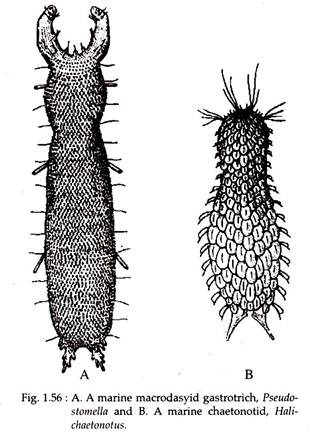In this article we will discuss about the Phylum Gastrotricha:- 1. Introduction to Phylum Gastrotricha 2. Diagnostic Features of Phylum Gastrotricha 3. Scheme of Classification.
Introduction to Phylum Gastrotricha:
Gastrotrichs have a minute (50 µm to 4 mm in length) body that is more or less transparent and dorsoventrally flattened. They inhabit marine and freshwater habitats. They are common animals of ponds, streams and lakes.
The intertidal zone of marine beaches may harbour more than 40 species. They feed on bacteria, protists and detritus that are swept into the mouth by the beating of buccal cilia or by pharyngeal pumping.
Etymology:
ADVERTISEMENTS:
Greek: gaster, stomach; thrix, hair
Diagnostic Features of Phylum Gastrotricha:
i. Vermiform, more or less transparent and bilaterally symmetrical.
ii. Body more than two cell layer thick with tissues and organs.
iii. Body comprising of an anterior head and an elongated trunk, the posterior part of which bears two or more adhesive organs.
ADVERTISEMENTS:
iv. Presence of an outer non-chitinous cuticle.
v. Body covered by cuticular scales, spines or hooks and bearing up to 250 adhesive tubes.
vi. The cilia is restricted on the ventral surface. It may be arranged in longitudinal bands or transverse rows or patches or grouped into cirri. In some forms uniform distribution of cilia is also evident.
vii. Gastrotrichs glide over the bottom by ventral cilia and can temporarily anchor by means of adhesive tubes that contain duo-gland organs.
ADVERTISEMENTS:
viii. Absence of a body cavity and are therefore, acoelomate.
ix. Presence of a straight gut and a sub-terminal anus.
x. Absence of a circulatory and respiratory system.
xi. There may be a single pair (chaetonotids) or several pairs (macrodasyids) of protonephridia that are primarily osmoregulatory in function.
xii. Nervous system comprises of two ganglionic masses, one on each side of the anterior pharynx, dorsally connected by a commissure and a pair of longitudinal cords.
xiii. They are hermaphrodites, with internal fertilization and direct development.
Scheme of Classification of Phylum Gastrotricha:
There are more than 450 known species in Gastrotricha, that has been divided between two orders—Macrodasyida and Chaetonotida. These two orders should have been elevated to class category after the elevation of class Gastrotricha (previously under phylum Aschelminthes) to phylum status. However, the two orders have not been formally recognised as classes.
The order (class) Macrodasyida has adhesive tubes located on anterior and posterior ends and on lateral sides of the body, presence of pharyngeal pores and several pairs of protonephridea. They are hermaphrodite and consist of marine and estuarine species.
Examples:
ADVERTISEMENTS:
Macrodasys, Pseudostomella (Fig. 1.56A), Turbanella, Dactylopodola, Urodasys.
The order (class) Chaetonotida has adhesive tubes restricted to the posterior end only, absence of pharyngeal pores and presence of a single pair of protonephridia. They are fresh water and marine animals, with most fresh water species having parthenogenetic females.
Examples:
Halichaetonotus (Fig. 1.56B), Chaetonotus, Lepidadermella, Xenotrichula.
